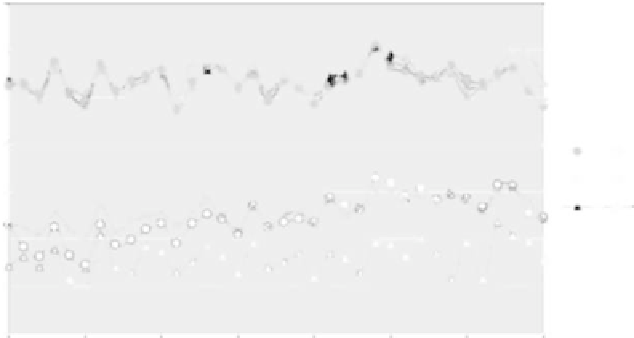Environmental Engineering Reference
In-Depth Information
3.5 Human-Dominated Effects within the Region
Embedded among the diverse desert climates and large ranges in temperature and precip-
itation in the Southwest terrain are human settlements with their own distinctive emerg-
ing local climatic regimes. One of the more recent interdisciplinary foci in climatology
today is a good example of the importance of appreciating processes at the local scale and,
at the same time, appreciating the time-varying state at this scale: that of studying the
urban environment and how cities are creating new local climates through time.
11
Scholars
who publish in this rapidly emerging area, and others, appreciate that well over half the
population now reside in cities. The contributors to this field are a diverse group that
includes climatologists foresters, weather forecasters, air quality and fluid dynamics spe-
cialists, architects and planners, transportation and material science specialists, construc-
tion industry specialists, urban ecologists, and policy-makers.
Cities in desert areas are growing rapidly, are within climate regimes dominated by
local-scale processes (stable air, less storms, terrain influences), and experience heat island
and precipitation effects a large portion of the time during a seasonal cycle, more so than
storm-dominated, moist climates on earth. As shown in Figure 3.6, minimum tempera-
tures in downtown Phoenix and the Phoenix Sky Harbor airport have increased since
1960, in comparison to a rural location at Sacaton, Arizona, some 20 miles to the southeast
of the Phoenix area.
Factors that contribute to urban heat excesses include: (1) increased surface area absorbing
the sun's energy due to vertical buildings and decreased albedo (surface reflectivity), (2) the
absorption rate of materials and storage of heat during a day, (3) the lack of wetness of the
surface and amount of vegetation and lakes, (4) the geometry of building arrangements
and the canyon-like heat trapping effect, (5) the emitted heat from buildings and roofs, (6)
transportation emissions and air-quality effects on heating and cooling within the city,
110
100
90
80
Airport
Phoenix city
70
Sacaton
60
50
40
1960
1965
1970
1975
1980
1985
1990
1995
FIGURE 3.6
Two urban-dominated surfaces (Phoenix downtown and Sky Harbor International Airport) versus the more
rural site of Sacaton, Arizona, about 20 miles southeast of Phoenix in the desert. Data are mean monthly maxi-
mum and minimum temperatures for May. Note the pronounced difference in the minimum temperature time
trend between urban sites and rural site.




Search WWH ::

Custom Search